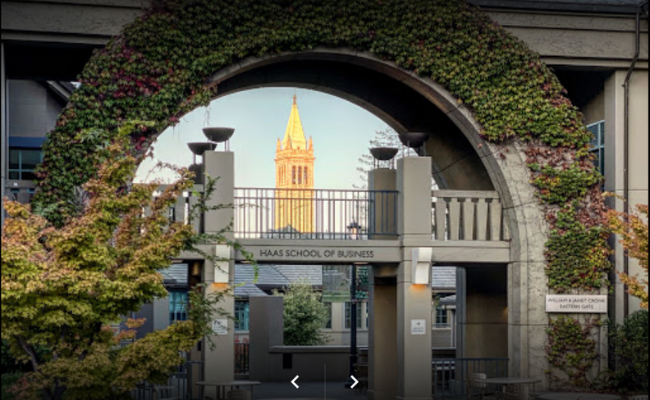
The business school of the University of California – The Haas School of Business (Berkeley Haas) finds a top rank in the list of the world’s best business schools in the Economist, Financial Times, QS World University Rankings, U.S. News & World Report, and Bloomberg Business week. It boasts Nobel laureates and top economists among the faculty.
The global pandemic caused by the novel corona-virus has gnawed its teeth into almost everything in the world, and educational institutions were not spared either.
The premier B-schools in the US had encountered a three-year dip in the volume of applications from 2016.
After facing the lowest acceptance rate for two years in a row – 11.8% in 2016 and 12 % in 2017, Berkeley Haas managed to improve in the following two years’ acceptance rate of 15.4% in 2018 and 17.7% in 2019.
Close on the lines of the Wharton School at the University of Pennsylvania, Columbia Business School, and NYU Stern School of Business, the Berkeley Haas School of Business received a whopping 860 admissions and acceptance of 23.7% this year.
What are the factors that contributed to an increase in applications?
Berkeley Haas, like most other universities, extended the deadline for its third round of applications this year for submission of the GMAT(Graduate Management Admission Test), the GRE (Graduate Record Exam), and all other test scores.
The two-month extension gave way for a flux of applications – they increased over five percent, from 3,450 applications last year to 3,636 this year. This surge was the first one of its kind witnessed by the B-school since 2016.
Peter Johnson, assistant dean of the full-time MBA program and admissions at Berkeley Haas, attributed the absence of limitations arising from physical enrolments to the increase in the class size.
It went up by forty-eight seats, a final of three hundred and thirty-one seats, the largest ever MBA class in the history of Berkeley Haas.
He believes that had the admission processes been physical, this feat may not have been possible. Two hundred and ninety-one was the previous highest class size in 2018. He said he was happy about the increase in several parameters despite facing a pandemic year.
What are the pluses and minuses?
The positives have been good at Berkeley Haas this year:
- Class size of 331 (291 in 2018)
- Average GMAT score of 727 (726 in 2018)
- Percent with GRE – 34% (21% in 2019)
- Acceptance rate of 23.7% (17.7% in 2019)
- 860 admissions (611 in 2018)
- 39% of minorities (32% in 2016)
What went down in2020:
- Average GRE score of 322 (329 in 2018)
- Average undergrad GPA of 3.65 (3.71 in 2017)
- 3,636 applications (4132 in 2017)
- 38.5% yield (56.9% in 2019)
- 39% of women students (43% in 2018)
- 21% international students (39% in 2017)
Most global universities could not counter a drop in international admissions. Mr. Johnson opined that visa and travel restrictions could account for the decline in global representation. Some view this as a temporary situation, but no one knows how and when this is likely to improve.
The Haas school had offered deferrals based on individual requirements and did not keep them open for all and sundry.
How does the pre-MBA profile fit?
The new batch looks quite different from the previous pre-MBA days.
| Pre-MBA background | 2019 (in percentages) | 2020 (in percentages) |
| Consulting | 20 | 21 |
| Financial services | 20 | 17 |
| Technical | 15 | 10 |
| Nonprofit | 11 | 7 |
| Healthcare/pharma/biotech | 5 | 8 |
| CPG/Retail | 5 | 6 |
| Energy | 4 | 5 |
| Military | 5 | |
| Government | 3 | |
| Entertainment | 3 | |
| Others | 13 |
What is the pre-MBA Educational background of the incoming batch?
| Stream | Figures in percentage |
| Economics | 17 |
| Engineering | 17 |
| Social sciences | 16 |
| Business / commerce | 13 |
| Finance | 9 |
| Humanities | 7 |
| Natural sciences | 5 |
| Mathematics | 2 |
Mr. Johnson seemed contended with the overall outcome and finds the batch of students diligent and smart. He converses with some of the students who stay at Berkeley, as they do not face time-zone issues.
The Haas school had worked to up the admission numbers by tweaking the admission procedure slightly. The admits went up from last year’s six hundred and eleven to eight hundred and sixty this year.
This hike of over forty percent opened the doors to increasing the school’s acceptance rate to an overall 33.9%, which makes it an almost hundred percent raise in four years. Here is looking forward to more such encouraging news in the education sector.
Stay connected with fellow students on PaGaLGuY for CAT Exam 2020 Discussion
Stay connected with fellow students on PaGaLGuY for GMAT Exam Discussions
